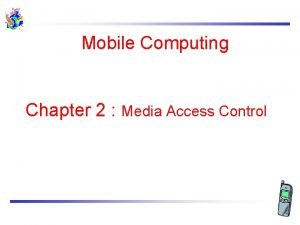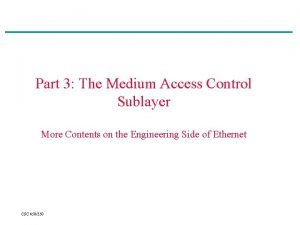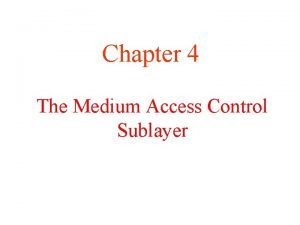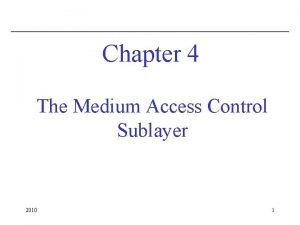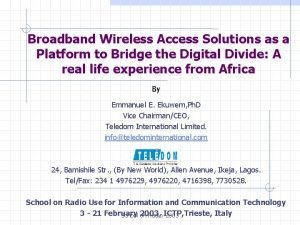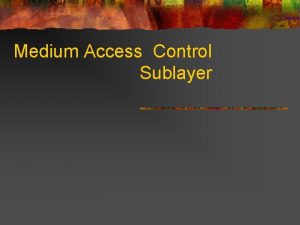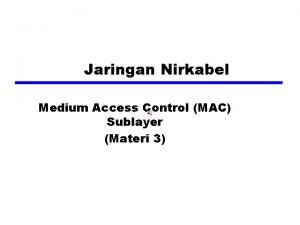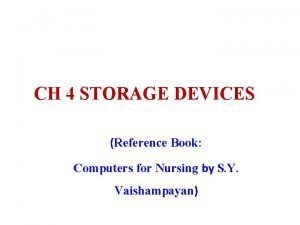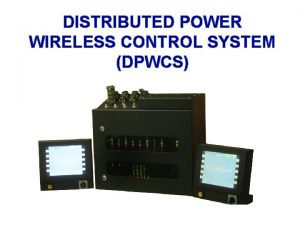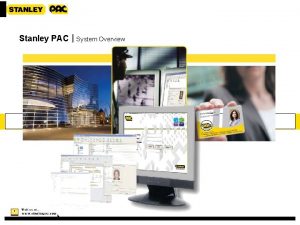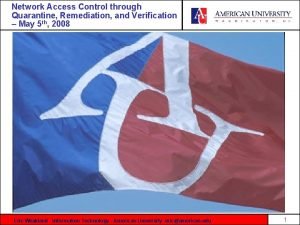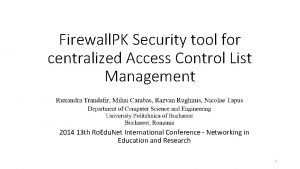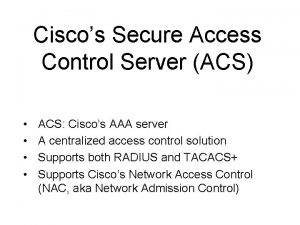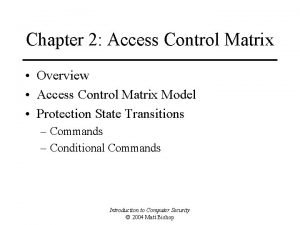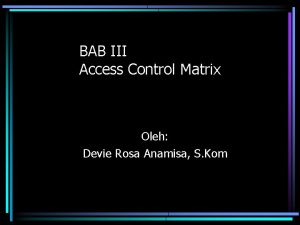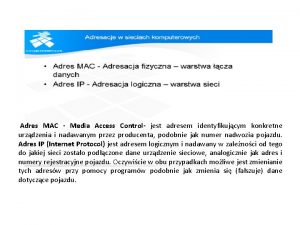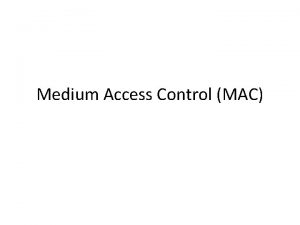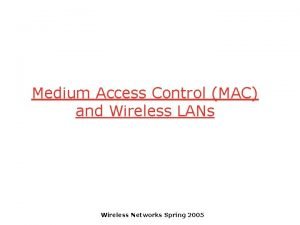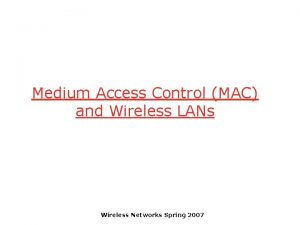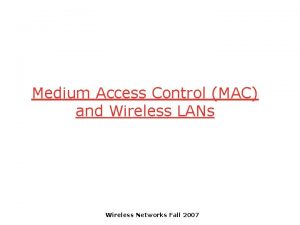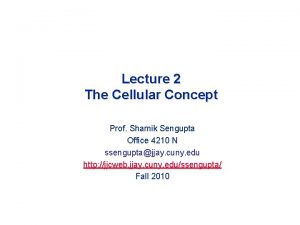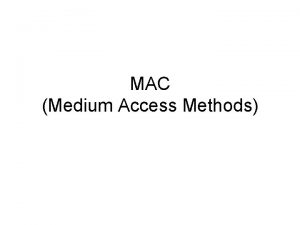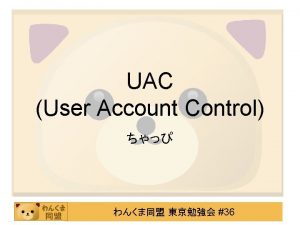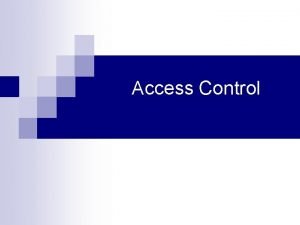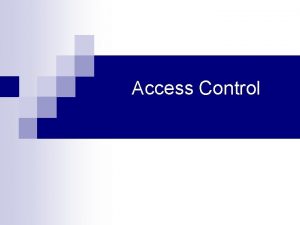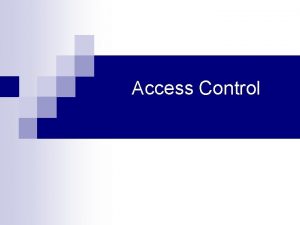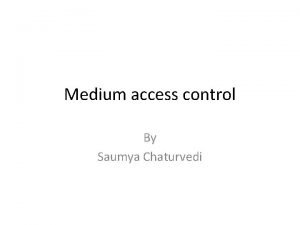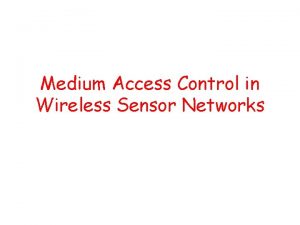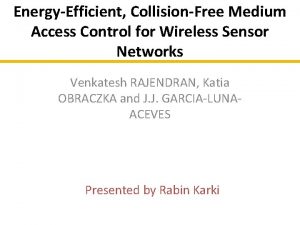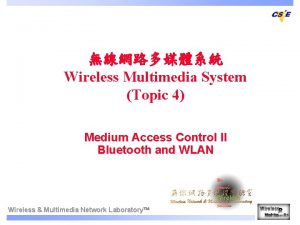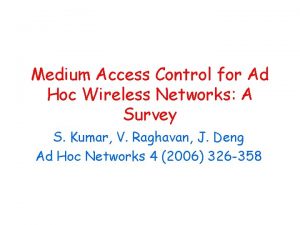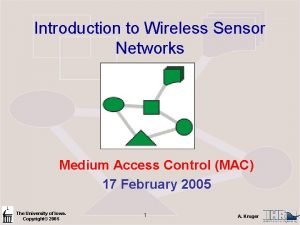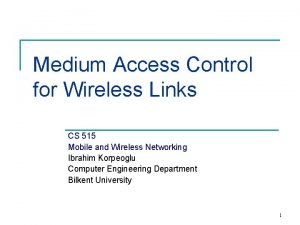Lecture 4 Wireless Medium Access Control Prof Shamik




































- Slides: 36

Lecture 4 Wireless Medium Access Control Prof. Shamik Sengupta Office 4210 N ssengupta@jjay. cuny. edu http: //jjcweb. jjay. cuny. edu/ssengupta/ Fall 2010

Medium Access Control (MAC) Base Station Forward link Reverse link Mobile Station

Earlier MAC Protocols: A quick overview Channel Partitioning: TDMA, FDMA – divide channel into “pieces” (time slots, frequency) – allocate piece to node for exclusive use Channel Partitioning: adv. , disadv. – Share channel efficiently at high load – inefficient at low load: delay in channel access, 1/N bandwidth allocated even if only 1 active node! cy Time C C f 2 B B A qu en · f 0 CBACBA Fre C A Fre B qu en cy · A f 1 f 0 Time

Earlier MAC Protocols: A quick overview · Packet Radio (PR) Access Technique: – Users attempt to access a single channel in an uncoordinated or random manner · Random Access: Aloha, Slotted Aloha – allow collisions – “recover” from collisions · Random access MAC protocols – efficient at low load: single node can fully utilize channel – high load: collision overhead

Pure (unslotted) ALOHA · Devised by Norman Abramson and his colleagues – University of Hawaii · Simple, no synchronization · when frame first arrives – transmit immediately · collision probability increases: – frame sent at t 0 collides with other frames sent in [t 0 -1, t 0+1]

Pure Aloha efficiency What is the efficiency?

Slotted ALOHA Assumptions: · all frames same size · time divided into equal size slots (time to transmit 1 frame) · nodes start to transmit only slot beginning · nodes are synchronized · if 2 or more nodes transmit in slot, all nodes detect collision Operation: · when node obtains fresh frame, transmits in next slot – if no collision: node can send new frame in next slot – if collision: node retransmits frame in each subsequent slot with prob. p until success

Slotted ALOHA Pros · single active node can continuously transmit at full rate of channel · highly decentralized: only slots in nodes need to be in sync · simple Cons · collisions, wasting slots · idle slots · nodes may be able to detect collision in less than time to transmit packet · clock synchronization

Slotted Aloha efficiency Efficiency : 37% At best: channel used for useful transmissions 37% of time! ! 5: Data. Link Layer 5 -9

Why Aloha protocols were disadvantageous? · Aloha protocols do not listen to the channel before transmission – Do not exploit info about other users · Listening to the channel if any user is transmitting is key to the efficient wireless access – This was the basic of CSMA protocols – Carrier Sense Multiple Access Protocol

Carrier Sense Multiple Access (CSMA) Protocol · Two imp parameters in CSMA – Detection delay – Propagation delay · Detection delay – A function of the receiver hardware – Time reqd for a terminal to sense whether or not the channel is idle · Propagation delay – Relative measure of how fast a packet travels from one station to another station (BS or AP) – Systems must be built taking this parameter significantly in account – High propagation delay impact efficiency – E. g. , two extreme transmitting users may get into collision again and again due to high propagation delay

Variations of CSMA · 1 -persistent CSMA – Listens to the channel, if idle transmit · p-persistent CSMA – Listens to the channel, if idle, transmit with prob p in the first slot or (1 -p) in the next slot · CSMA/CD – Further improvement over earlier CSMA – Not only listens to channel before transmissions but also during transmissions – If collision is detected, transmissions are aborted immediately – Saves valuable resources from wastage – Combines “listen before talk” and “listen while talk” – Happens in Ethernet (because of full-duplex radios)

CSMA in wireless · The concept of CSMA/CD is interesting – How about applying it in wireless medium access control? · Problems in wireless networks – signal strength decreases proportional to the square of the distance – the sender would apply CS and CD, but the collisions happen at the receiver – a sender cannot “hear” the collision at the same time of transmission, because transmission power suppresses receiving power – i. e. , CD does not work – furthermore, CS might not work if, e. g. , a terminal is “hidden” · Wireless MAC use variants of CSMA – CSMA/CA (collision avoidance protocol) – Does not make collision zero, just tries to reduce it – Very popular in IEEE 802. 11 (WLAN)

IEEE 802. 11 infrastructure network AP AP ad-hoc network wired network AP: Access Point AP

802. 11 infrastructure mode ·Station (STA) 802. 11 LAN 802. x LAN – terminal with access mechanisms to the wireless medium and radio contact to the access point ·Basic Service Set (BSS) STA 1 BSS 1 Portal Access Point Distribution System – station integrated into the wireless LAN and the distribution system – bridge to other (wired) networks ·Distribution System BSS 2 STA 2 ·Access Point ·Portal Access Point ESS – group of stations using the same radio frequency 802. 11 LAN STA 3 – interconnection network to form one logical network (ESS: Extended Service Set) based on several BSS

802. 11: ad-hoc mode · 802. 11 LAN STA 1 STA 3 BSS 1 – Station (STA): terminal with access mechanisms to the wireless medium – Basic Service Set (BSS): group of stations in range and using the same radio frequency STA 2 BSS 2 STA 5 STA 4 Direct communication within a limited range 802. 11 LAN

IEEE standard 802. 11 fixed terminal mobile terminal server infrastructure network access point application TCP IP IP LLC LLC 802. 11 MAC 802. 3 MAC 802. 11 PHY 802. 3 PHY

How does the medium access work in WLAN? Contention Based Distributed Coordination Function (DCF) · Contention Free Point Coordination Function (PCF) Access methods – DCF CSMA/CA (mandatory) – collision avoidance via exponential backoff – Minimum distance (IFS) between consecutive packets – ACK packet for acknowledgements (not for broadcasts) – DCF with RTS/CTS (optional) – Distributed Foundation Wireless MAC – avoids hidden terminal problem – PCF (optional) – access point polls terminals according to a list

802. 11 – MAC · Priorities – defined through different inter frame spaces – SIFS (Short Inter Frame Spacing) – highest priority, for ACK, CTS, polling response – PIFS (PCF IFS) – medium priority, for time-bounded service using PCF – DIFS (DCF, Distributed Coordination Function IFS) – lowest priority, for asynchronous data service, competing stations DIFS medium busy DIFS PIFS SIFS direct access if medium is free DIFS contention next frame t

WLAN CSMA/CA access method DIFS medium busy direct access if medium is free DIFS · contention window (randomized back-off mechanism) next frame t slot time Station ready to send – starts sensing the medium (Carrier Sense) · · If the medium is free for the duration of an Inter-Frame Space (IFS), the station can start sending (IFS depends on service type) If the medium is busy, the station has to wait for a free IFS, then the station must additionally wait a random back-off time – collision avoidance, multiple of slot-time · If another station occupies the medium during the back-off time of the station, the back-off timer freezes

WLAN access scheme details · Sending unicast packets – station has to wait for DIFS before sending data – receivers acknowledge at once (after waiting for SIFS) if the packet was received correctly (CRC) – automatic retransmission of data packets in case of transmission errors DIFS sender data SIFS receiver ACK DIFS other stations waiting time data t contention

Contention for channel · When the other stations find the channel idle, they would like to transmit their own packets – Contention for channel · If all the waiting stations attempt at once, this will surely result in collision – Some CA scheme is necessary – Backoff intervals can be used to reduce collision probability

Backoff Interval · When transmitting a packet, choose a backoff interval in the range [0, cw] – cw is contention window · Count down the backoff interval when medium is idle – Count-down is suspended if medium becomes busy · When backoff interval reaches 0, transmit packet B 1 = 25 B 1 = 5 wait data B 2 = 20 Assume cw = 31 wait B 2 = 15 B 2 = 10 B 1 and B 2 are backoff intervals at nodes 1 and 2

Backoff Interval · The time spent counting down backoff intervals is a part of MAC overhead – Choosing a large cw leads to large backoff intervals and can result in larger overhead – Choosing a small cw leads to a larger number of collisions (when two nodes count down to 0 simultaneously) · Since the number of nodes attempting to transmit simultaneously may change with time, some mechanism to manage contention is needed – IEEE 802. 11 DCF: contention window cw is chosen dynamically depending on collision occurrence – Follows Binary exponential backoff algorithm

Binary Exponential Backoff (BEB) in DCF · Even before the first collision, nodes follow BEB · Initial backoff interval (before 1 st collision) – [0, 7] · If still packets collide, double the collision interval – [0, 15], [0, 31] and so on… · Express this binary exponential backoff interval as a function of collision number

Numerical example #1 · Two nodes, A and C both waiting for a busy channel to be idle so that they can proceed with their first transmission. After the channel becomes idle, what is the probability of A and C colliding in their first transmissions?

Numerical example #2 · Two nodes, X and Y intend to transmit frames of 10 and 5 timeslots. Initially after waiting for DIFS, X and Y both generate random backoff number, r. X and r. Y as 2. In the next stage, X generates r. X =1 and Y generates r. Y =3. What will be the time (slots) taken to complete both transmissions and receive acks? – Assume, SIFS=1 timeslot, DIFS=2 timeslots

Avoiding collisions (more) idea: allow sender to “reserve” channel rather than random access of data frames: avoid collisions of long data frames · · · sender first transmits small request-to-send (RTS) packets to BS using CSMA – RTSs may still collide with each other (but they’re short) BS broadcasts clear-to-send CTS in response to RTS CTS heard by all nodes – sender transmits data frame – other stations defer transmissions avoid data frame collisions completely using small reservation packets!

Collision Avoidance: RTS-CTS exchange B A AP RTS(B) RTS(A) reservation collision RTS(A) CTS(A) DATA (A) defer time ACK(A)

802. 11 access scheme details – RTS/CTS · Sending unicast packets – station can send RTS with reservation parameter after waiting for DIFS (reservation determines amount of time the data packet needs the medium) – ack via CTS after SIFS by receiver (if ready to receive) – sender can now send data at once, acknowledgement via ACK – other stations store reservations distributed via RTS and CTS DIFS sender RTS data SIFS receiver other stations CTS SIFS NAV (RTS) NAV (CTS) defer access ACK DIFS data t contention

802. 11 Steps – RTS/CTS · All backlogged nodes choose a random number, R · Each node counts down R – Continue carrier sensing while counting down – Once carrier busy, freeze countdown · Whoever reaches ZERO transmits RTS – Neighbors freeze countdown, decode RTS – RTS contains (CTS + DATA + ACK) duration = T_comm – Neighbors set NAV = T_comm – Remains silent for NAV time 31

802. 11 Steps – RTS/CTS · Receiver replies with CTS – Also contains (DATA + ACK) duration. – Neighbors update NAV again · Tx sends DATA, Rx acknowledges with ACK – After ACK, everyone initiates remaining countdown – Tx chooses new R = rand (0, CW) · If RTS or DATA collides (i. e. , no CTS/ACK returns) – Indicates collision – RTS chooses new random no. following BEB 32

Numerical example #3 · Two nodes, X and Y intend to transmit frames of 10 and 5 timeslots. Initially after waiting for DIFS, X and Y both generate random backoff number, r. X and r. Y as 2. In the next stage, X generates r. X =1 and Y generates r. Y =3. What will be the time (slots) taken to complete both transmissions and receive acks? – Assume, SIFS=1 timeslot, DIFS=2 timeslots – RTS threshold = 8.

Another special access – with Fragmentation DIFS sender RTS frag 1 SIFS receiver CTS SIFS frag 2 SIFS ACK 1 SIFS ACK 2 NAV (RTS) NAV (CTS) other stations NAV (frag 1) NAV (ACK 1) DIFS contention data t

Point Coordination Function t 0 t 1 medium busy PIFS D 1 point SIFS coordinator wireless stations‘ NAV Super. Frame SIFS D 2 SIFS U 1 U 2 NAV

Point Coordination Function t 2 point coordinator wireless stations‘ NAV D 3 PIFS SIFS D 4 t 3 t 4 CFend SIFS U 4 NAV contention free period contention period t
 Csma in mobile computing
Csma in mobile computing The medium access control sublayer
The medium access control sublayer Mac sublayer is stacked at
Mac sublayer is stacked at Medium access control sublayer
Medium access control sublayer Telecommunications the internet and wireless technology
Telecommunications the internet and wireless technology Terminal access controller access control system plus
Terminal access controller access control system plus Terminal access controller access-control system
Terminal access controller access-control system Hot media cool media
Hot media cool media Medium medium 35m newton
Medium medium 35m newton 01:640:244 lecture notes - lecture 15: plat, idah, farad
01:640:244 lecture notes - lecture 15: plat, idah, farad Wireless guest access solution
Wireless guest access solution Toast install
Toast install Wireless access point attack vector
Wireless access point attack vector Wireless access solutions
Wireless access solutions Medium access sublayer
Medium access sublayer Medium access sublayer
Medium access sublayer Channel allocation problem in medium access sublayer
Channel allocation problem in medium access sublayer Y1st
Y1st The access method used for magnetic tape is
The access method used for magnetic tape is Dpwfs
Dpwfs Unified access control
Unified access control Stanley pac software
Stanley pac software Secure server access
Secure server access Keepcoding login
Keepcoding login Network access quarantine control
Network access quarantine control Integrated security corporation
Integrated security corporation Security access matrix
Security access matrix Centralized access control
Centralized access control 1997
1997 Alwin alcea
Alwin alcea Volo cloud based access control
Volo cloud based access control Secure access acs
Secure access acs Originator controlled access control
Originator controlled access control Access control matrix
Access control matrix Media access control methods
Media access control methods User access matrix
User access matrix Mac (media access control)
Mac (media access control)
